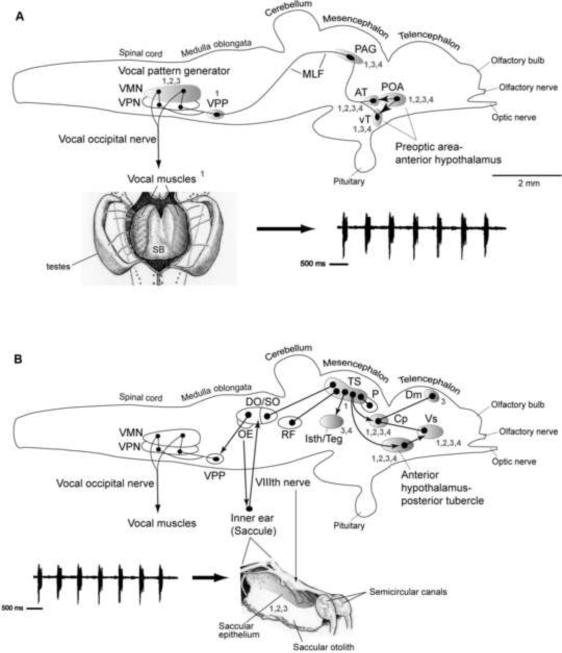Fig. 4.
Side views of the brain showing vocal motor (A) and auditory (B) systems in batrachoidid fish (midshipman and toadfish) (adapted from Forlano et al., 2010). Solid dots represent somata, and lines represent axonal projection pathways. Two connected dots indicate reciprocal connections. Shaded areas indicate localization of steroid hormone receptor mRNA (1, androgen; 2, estrogen alpha), aromatase (3), and neuropeptide innervation (4, arginine vasotocin/isotocin) (see Forlano et al., 2005; Forlano et al., 2001; Forlano et al., 2010; Goodson and Bass, 2000b; Goodson et al., 2003). A; Descending vocal pathways. Preoptic (POA) and hypothalamic ventral (vT) and anterior (AT) tuberal nuclei project to the midbrain periaqueductal gray (PAG) which innervates, in turn, the vocal pattern generator circuit (VPG) in the hindbrain-spinal cord. The VPG consists of vocal prepacemaker (VPP), pacemaker (VPN) and motor (VMN) nuclei. VMN axons exit the brain via occipital nerve roots (likely homologues of hypoglossal) to sound-producing vocal muscle attached to the swim bladder (ventral view). Also shown is a representative “grunt train” vocalization produced by nest guarding male. B: Central auditory pathways. Vocalizations (e.g., grunt train) are detected by auditory saccule within the inner ear which projects via the VIIIth nerve to auditory nuclei in the hindbrain that innervate the auditory midbrain torus semicircularis (TS). Shown are nuclei interconnected with TS. A dorsal thalamic nucleus (central posterior nucleus, CP) contains reciprocal connections to the telencepahlon (dorsomedial/Dm) and ventral supracommissural/Vs) that receives input from anterior hypothalamus-posterior tubercle (for nomenclature see Braford and Northcutt, 1983). TS and CP also connect to forebrain (anterior hypothalamus, POA) and midbrain (PAG, isthmal/tegmentum) vocal sites, while auditory-recipient hindbrain nuclei connect to the pattern generating VPG circuit (also see Bass et al., 1994; Goodson and Bass, 2002). See Forlano et al. (2010) for additional background references.

